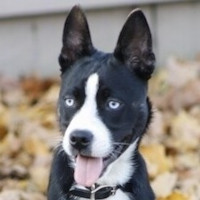Appearance of the Siberian Boston
|
| The Siberian Boston has the best of both parent breeds' characteristics. It generally weighs between 9 and 18 kilos at maturity, depending largely on the dominant breed. They are slender, with high, erect ears. He may have blue eyes, or one brown and one blue eye; some say he has a “glass” eye. He will probably have the longer muzzle of the Siberian Husky's parent breed, but this is not guaranteed. He is likely to be black over most of his body, with white markings on his chest and belly. He may have a white patch on his face. His tail is likely to be long and slightly curved. His actual coat depends on the dominant parental breed. It may therefore have the thick undercoat of the Siberian Husky parent breed plus the short outer coat of the Boston Terrier parent breed. |
Temperament of the Siberian Boston
|
| The Siberian Boston is a lively, energetic and intelligent dog. They are also very affectionate. They may bond particularly well with one member of the family. However, he loves every member of the family and is happiest when surrounded by them. He makes a good watchdog. He has no problem alerting his family to anything out of place on his territory. He's eager to please his human family, which makes him fairly easy to train. Be aware, however, that he can have a stubborn streak. Patience and perseverance are essential when working with a Boston Siberian. He can suffer from separation anxiety, which makes the Siberian Boston not a good dog for families who aren't home regularly. He's happiest when curled up on the sofa with you, or perhaps sitting on your lap, if you allow it. He's a gentle, fun addition to any family. |
Needs and activities of the Siberian Boston
|
| The Siberian Boston needs a moderate amount of activity. Don't forget that he's highly intelligent. He's a working dog, and it's at work that he's happiest. The Boston Terrier is a lively little dog that also enjoys mental stimulation. To keep him busy, be sure to provide plenty of toys to stimulate his mind. In addition, you'll want to provide him with chew toys. Both parent breeds are known to destroy furniture and shoes when bored. For physical activity, brisk walks around the neighborhood are a great idea. He'll appreciate the dog park, but don't take him there until you've trained him to come back to you on your command. If you plan to give him free time in a fenced-in area, make sure the fence is at least 1.80 m high and anchored deep into the ground. The Siberian Husky's parent has been known to climb out of or dig under fences to find new territory to explore. |
Maintenance of the Siberian Boston
|
| The Siberian Boston may or may not require a great deal of maintenance. This depends on the type of coat it inherits from its parents. If he inherits the short coat of his Boston Terrier parents, you can expect him to be low-maintenance. All he'll need is a monthly brushing to rid his body of excess hair. In spring and autumn, to combat shedding, you'll need to brush him once a week to keep your clothes and furniture free of hair. If he inherits the Husky parent's double coat, you'll need to be prepared for a “brush stroke” twice a year. This will happen in spring and autumn. During this period, it's best to brush him daily to rid him of excess hair. Bathe him only when necessary. Brush his teeth two or three times a week to prevent tartar build-up and bad breath. However, to avoid cavities, brush every day. Trim his nails once a month. You may need to do this twice a month, especially if he doesn't wear out his nails on his own. |









 English (United Kingdom)
English (United Kingdom)